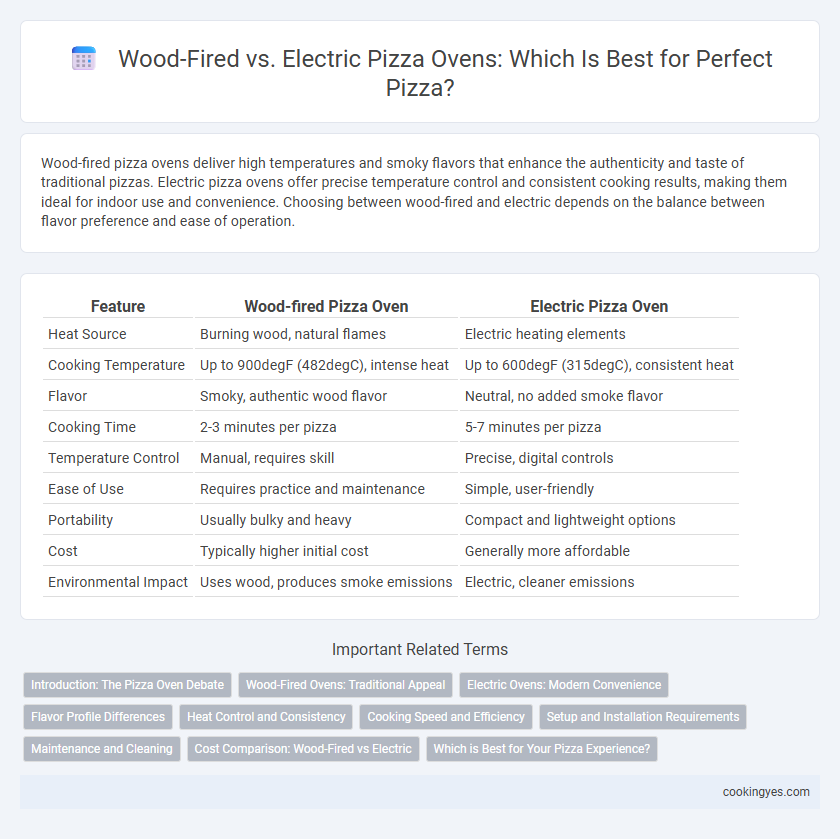Wood-fired pizza ovens deliver high temperatures and smoky flavors that enhance the authenticity and taste of traditional pizzas. Electric pizza ovens offer precise temperature control and consistent cooking results, making them ideal for indoor use and convenience. Choosing between wood-fired and electric depends on the balance between flavor preference and ease of operation.
Table of Comparison
| Feature | Wood-fired Pizza Oven | Electric Pizza Oven |
|---|---|---|
| Heat Source | Burning wood, natural flames | Electric heating elements |
| Cooking Temperature | Up to 900degF (482degC), intense heat | Up to 600degF (315degC), consistent heat |
| Flavor | Smoky, authentic wood flavor | Neutral, no added smoke flavor |
| Cooking Time | 2-3 minutes per pizza | 5-7 minutes per pizza |
| Temperature Control | Manual, requires skill | Precise, digital controls |
| Ease of Use | Requires practice and maintenance | Simple, user-friendly |
| Portability | Usually bulky and heavy | Compact and lightweight options |
| Cost | Typically higher initial cost | Generally more affordable |
| Environmental Impact | Uses wood, produces smoke emissions | Electric, cleaner emissions |
Introduction: The Pizza Oven Debate
Wood-fired pizza ovens deliver intense heat, often reaching temperatures above 900degF, creating a unique smoky flavor and perfectly charred crust favored by traditionalists. Electric pizza ovens provide precise temperature control and consistent heat distribution, making them ideal for home use and beginners seeking convenience without compromising quality. Selecting between wood-fired and electric ovens depends on individual preferences for flavor authenticity, ease of use, and cooking style.
Wood-Fired Ovens: Traditional Appeal
Wood-fired pizza ovens offer authentic flavor by reaching high temperatures above 800degF, creating a perfect crispy crust with a slightly smoky taste that electric ovens cannot replicate. The radiant heat from the burning wood cooks pizzas evenly and quickly, preserving moisture while imparting a distinctive char. Wood-fired ovens are favored by traditionalists and gourmet chefs seeking a rustic cooking experience and superior, artisanal pizza quality.
Electric Ovens: Modern Convenience
Electric pizza ovens offer precise temperature control, ensuring consistent cooking results ideal for home use or small pizzerias. Unlike wood-fired ovens, electric models require less maintenance, emit no smoke, and provide safer indoor operation. Their compact design and energy efficiency make electric ovens a popular choice for modern kitchens seeking convenience without sacrificing pizza quality.
Flavor Profile Differences
Wood-fired pizza ovens infuse pies with a smoky, charred flavor achieved from burning hardwood, creating a distinctive, rustic taste that enhances the crust's crispiness. Electric pizza ovens maintain consistent heat, producing a cleaner, more neutral flavor that allows toppings' natural tastes to stand out without the smoky undertones. The choice between wood-fired and electric ovens significantly impacts the pizza's aroma, crust texture, and overall flavor complexity.
Heat Control and Consistency
Wood-fired pizza ovens offer dynamic heat control through manual adjustment of fire intensity and positioning, creating unique flavor profiles but requiring skill to maintain consistent temperature. Electric pizza ovens provide precise and stable heat control with digital temperature settings, ensuring uniform cooking and repeatable results ideal for both home and commercial use. Consistency in electric ovens reduces the learning curve, while wood-fired ovens deliver authentic artisanal quality with variable heat distribution.
Cooking Speed and Efficiency
Wood-fired pizza ovens cook at higher temperatures, reaching up to 900degF, allowing pizzas to cook in as little as 90 seconds, which enhances overall speed. Electric pizza ovens maintain consistent heat with precise temperature control, offering efficient energy use but generally require longer cooking times, around 4 to 6 minutes per pizza. Wood-fired ovens excel in rapid cooking due to intense radiant heat, while electric ovens provide steady efficiency suited for consistent, repeatable results.
Setup and Installation Requirements
Wood-fired pizza ovens require a dedicated outdoor space with proper ventilation, a sturdy base, and often professional installation to manage smoke and high temperatures safely. Electric pizza ovens offer simpler setup options, typically needing only a standard electrical outlet, making them suitable for indoor or compact spaces. Installation of electric ovens is generally faster and less costly compared to wood-fired models due to fewer structural modifications.
Maintenance and Cleaning
Wood-fired pizza ovens require regular removal of ash and soot buildup to maintain optimal heat retention and avoid flavor contamination, while electric pizza ovens need periodic cleaning of heating elements and drip trays to prevent residue and ensure consistent temperature control. Wood-fired ovens benefit from occasional chimney inspections to prevent creosote buildup, whereas electric ovens demand less frequent but thorough wiping of interior surfaces to avoid electrical issues. Proper maintenance of each type directly impacts cooking performance and longevity, with wood-fired ovens generally requiring more hands-on care due to combustion byproducts.
Cost Comparison: Wood-Fired vs Electric
Wood-fired pizza ovens typically have higher upfront costs due to the need for specialized materials and installation, often ranging from $1,000 to $3,000 or more. Electric pizza ovens generally have lower initial prices, starting around $200 and going up to $1,000, making them accessible for home use. Operating costs for wood-fired ovens include wood fuel expenses, while electric ovens incur electricity costs, which vary regionally but tend to be more consistent and easier to manage.
Which is Best for Your Pizza Experience?
Wood-fired pizza ovens offer high temperatures up to 900degF, creating a crispy, smoky crust ideal for traditional Neapolitan-style pizzas, while electric ovens provide consistent heat control and ease of use, making them suitable for home cooks seeking convenience and versatility. Wood-fired ovens require more skill and maintenance but deliver authentic flavor and texture, whereas electric ovens offer precise temperature settings and faster start-up times, accommodating varied pizza styles. Choosing between the two depends on your priority for authentic taste versus operational simplicity and space considerations.
Wood-fired vs Electric for pizza oven Infographic

 cookingyes.com
cookingyes.com